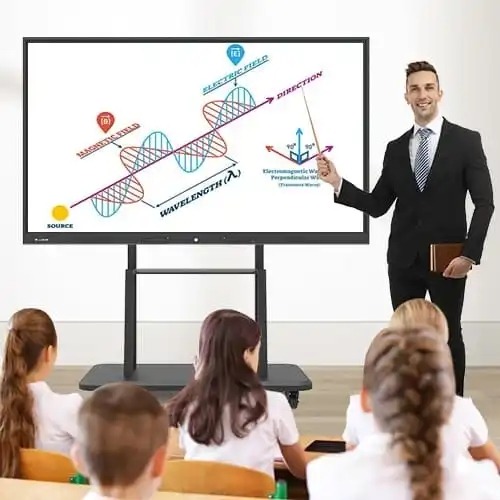What is the use of interactive whiteboard?
Interactive whiteboards, also known as smartboards or digital whiteboards, are electronic displays that are designed for use in classrooms, conference rooms, and other settings where interactive presentations and collaboration are needed. They are typically mounted on a wall or on a stand and are connected to a computer, allowing users to control and manipulate digital content using a pen or their fingertips.
Interactive whiteboards have a variety of uses and can be an effective tool for enhancing communication and productivity in a range of settings. Some of the main benefits and uses of interactive whiteboards include:
The main use of interactive whiteboard as below
Interactive whiteboards can be used to deliver dynamic and engaging presentations, allowing presenters to easily incorporate multimedia content such as images, videos, and websites into their presentations. They also make it easy for presenters to write and draw on the screen, allowing for more interactive and visual presentations.
Interactive whiteboards are often used in classrooms to enhance the teaching and learning experience. Teachers can use them to present information, illustrate concepts, and engage students in interactive activities. Students can also use the whiteboards to collaborate on projects and share their work with the class.
Interactive whiteboards can be used to facilitate collaboration among team members, whether they are in the same room or working remotely. They allow users to share and edit documents, hold video conferences, and work together on projects in real-time.
Interactive whiteboards are generally easy to use and can be operated by people of all ages. They are often equipped with intuitive touch screen technology, making it easy to write, draw, and interact with digital content.
Interactive whiteboards can be used in a variety of settings and for a range of purposes, from presentations and meetings to classrooms and training sessions. They are also portable and can be easily moved from one location to another.
Interactive whiteboards can be integrated with other technologies such as laptops, tablets, and smartphones, allowing users to share and collaborate on content from multiple devices.
Overall, interactive whiteboards are a versatile and effective tool for enhancing communication and collaboration in a variety of settings. They provide a dynamic and interactive platform for presenting and sharing information and can be used to improve productivity and engagement in a range of contexts.
The use of interactive whiteboard in Meetings
Interactive whiteboards can be used to display and present information such as slides, documents, and videos during meetings.
Participants can use the interactive whiteboard to brainstorm and collaborate on ideas by drawing, writing, and adding notes to the display.
Interactive whiteboards can be used to facilitate discussions by allowing participants to add comments and feedback to the display in real-time.
Interactive whiteboards can be used to share and store information by saving notes and drawings to the board’s internal memory or to a cloud-based storage system.
Interactive whiteboards can help to enhance engagement by allowing participants to interact with the display and participate in the conversation in a more dynamic and interactive way
THE USE OF INTERACTIVE WHITEBOARD IN education

Interactive whiteboards can be used to display and present information such as slides, documents, and videos to students.
Students can use the interactive whiteboard to brainstorm and collaborate on ideas by drawing, writing, and adding notes to the display.
Interactive whiteboards can help to enhance student engagement by allowing them to interact with the display and participate in the lesson in a more dynamic and interactive way.
Teachers can use interactive whiteboards to differentiate instruction by adapting the content and pace of the lesson to meet the needs of individual students or small groups.
Interactive whiteboards can be used to assess student learning by creating interactive quizzes and assessments that can be completed on the board.
Interactive whiteboards can enhance visual aids such as maps, diagrams, and videos by making them more interactive and engaging for students.
